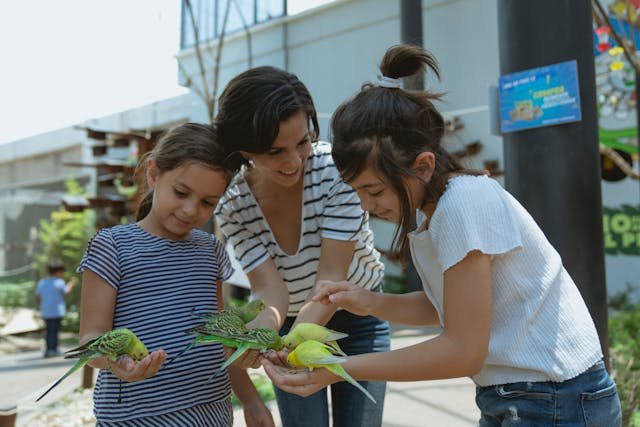Digital Habits That Help the Planet—and the Birds
Every tap, swipe, and scroll hums quietly beneath the surface—energy flows, servers awaken, and somewhere, a bird’s forest edge gets a little thinner. Digital life feels weightless, but it isn’t. The carbon footprint of your online behavior is as real as the exhaust from a car, just far less visible. We don’t think twice about streaming a video or letting our inbox swell with unread promotions, yet each action contributes to a chain of demand that hits the planet hard. And the impacts? They echo in the places we rarely connect to our screens—migratory routes, wetland ecosystems, fragile treetops. This isn’t about guilt, it’s about awareness—and the surprisingly powerful role your digital habits can play in shaping a cleaner world, for all of us, and especially for the birds.
Invisible Costs of Scrolling
You wake up, check your phone, scroll through three apps, delete a few emails you didn’t ask for, and stream a short video while brushing your teeth. Normal. Daily. Harmless? Not quite. Each of those interactions pulls from a vast digital infrastructure—data centers, networks, cooling systems—all humming with energy demands. While our screens remain cool and bright, their footprints extend far beyond what we see. The digital energy cost is real, and like most costs, someone—or something—ends up paying for it.
We Don’t See It, So We Don’t Change It
The tricky part? Most people still think of emissions as the smoke from a tailpipe or the haze above a factory. But every online action—yes, even this one—draws power, and often, that power isn’t clean. A recent study showed how surprisingly low awareness of digital emissions still is, even among those who consider themselves environmentally conscious. We often optimize for convenience, not carbon. But carbon doesn't care about intention. It accumulates with every click, download, or autoplayed reel. The invisible nature of digital impact makes it easy to ignore—but also dangerously easy to grow.
What You Study Now Could Shape the Infrastructure Later
Education is catching up—slowly. Curricula in computer science and IT are starting to fold environmental literacy into their foundations. Sustainable software isn’t just efficient; it’s ethical. Programs that encourage students to model system design based on lifecycle energy use, for instance, equip future developers to think beyond speed and cost. Understanding how software choices ripple through real-world infrastructure could soon be as essential as learning to code itself. If you’re curious about what that kind of curriculum looks like, take a look at this.
Digital Sustainability Starts with Intentional Choices
The good news: once you know, you can change. The better news: change doesn’t require perfection. A simple shift—like reducing cloud storage bloat or turning off video during unnecessary Zooms—has a measurable effect. Researchers have begun quantifying computation’s carbon footprint with far more granularity, highlighting how different behaviors compound over time. Even deleting old files from cloud accounts can reduce the power required to maintain storage over the long term. Efficiency isn’t about being a digital minimalist; it’s about being intentional. It’s choosing not to hoard, stream, or sync more than you need.
Not All Platforms Are Equal
This doesn’t mean abandoning the internet or becoming a Luddite. But it does mean interrogating the platforms we use most. Take social video apps. Their constant refresh cycles and auto-play mechanics aren’t just addictive—they’re computationally expensive. Choosing to limit time on such platforms—or at least adjusting settings to reduce autoplay—can lower demand. When millions make even tiny tweaks, the aggregate impact is massive. TikTok’s carbon footprint outpaces that of many other mainstream apps due to high-resolution streaming and algorithmic churn.
Why Birdsong Belongs in This Conversation
Yes, birds. This isn’t just about us. Bird populations are some of the most sensitive indicators of ecological stress, and the systems that support them—wetlands, forests, grasslands—are often first to feel the heat. These bird habitats store huge carbon, acting as natural buffers that soak up emissions we fail to reduce. But their ability to do that depends on stability. As digital habits fuel indirect emissions, those emissions fuel the climate shifts that fragment, dry out, or flood bird territory. The connection may feel distant, but it's not abstract. It's real, and it’s urgent.
How Restoration Bridges the Digital and the Wild
That urgency becomes even clearer when you look at how restoration efforts intersect. Rewilding, replanting, and preserving green corridors don’t just protect nests—they also create massive carbon sinks. And when fewer emissions are released in the first place, these efforts don't have to work as hard. Forest restoration aids both birds and carbon reduction simultaneously. This is why digital sustainability is not a sideshow; it’s a front-line tactic. It’s one of the few areas where a keystroke today could save a migration path tomorrow.
None of this is theoretical. The clicks you make, the platforms you use, and the practices you maintain—they form a digital ecosystem that has very real consequences for the physical one. And when birds go silent, when forests shrink, when coastlines reshape, they won’t care whether the carbon came from a highway or a server rack. The only thing that matters is what happens now. Start small. Stay aware. Log off when you can. Speak up when it matters. The earth may be wired differently these days, but it's still listening. So are the birds.
Discover a world of avian wonders at the Bird Directory, your go-to human-edited directory for the best resources on pet and wild birds, birding vacations, and more!
Copyright © 2008-2025 BirdSites.net. All rights reserved.

